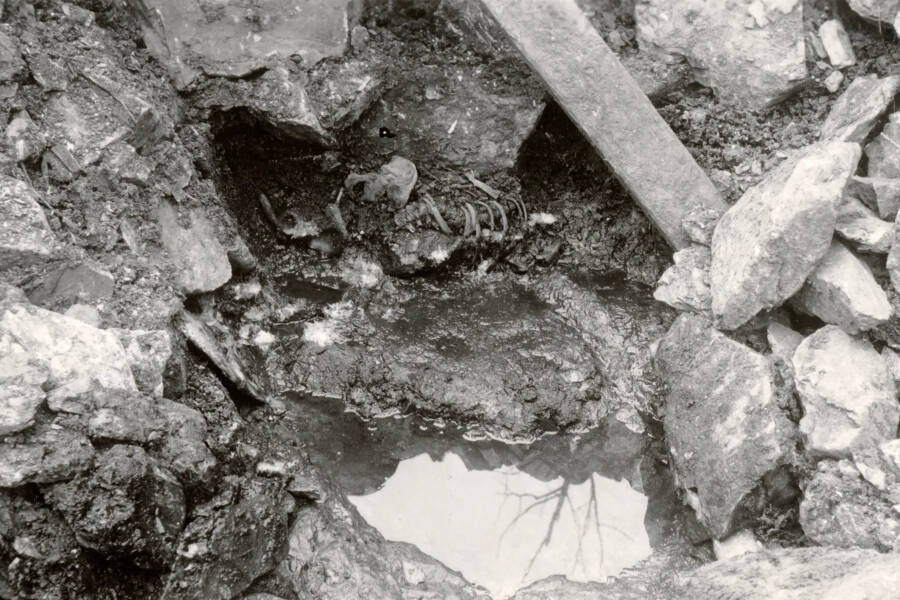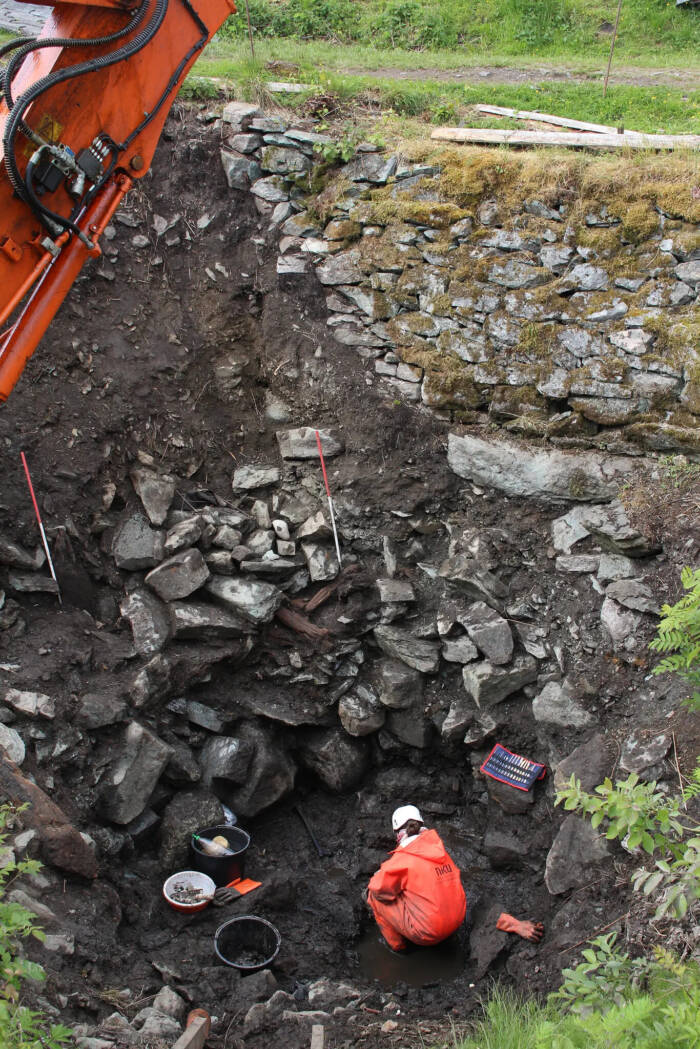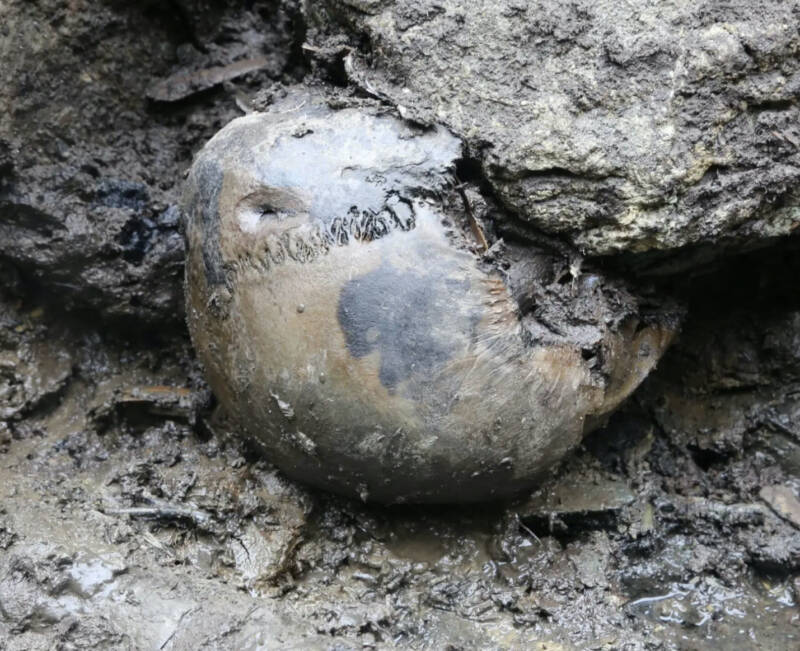The remains of a man found near Norway's Sverresborg Castle may confirm a Norse saga's tale of a victim thrown into a well to poison the water supply during an assault in 1197.

Norwegian Institute for Cultural HeritageThe remains of the “Well Man” when they were first found in Sverresborg, Norway in 1938.
In an archaeological discovery that’s been decades in the making, researchers have uncovered new evidence related to a storied episode from Norway’s medieval history. Recent excavations at Sverresborg Castle revealed further remains of a man found at the bottom of a 21-foot well, a finding that expanded on the original discovery in 1938.
According to Norse legend described in the Sverris Saga, a man was cast into the well during an 1197 raid on the castle. Though the story’s legitimacy has long been debated by historians, it has now gained credibility as researchers link the remains of the “Well Man” to documented events from Norway’s civil war era from 1130 to 1240.
Modern genetic testing and radiocarbon dating shows that the remains are 800-900 years old, aligning the timeline of the Well Man’s death with the events of the Sverris Saga.
This discovery sheds light on an important historical episode but also stands as a landmark moment in archaeology, representing the first time that researchers have genetically identified the remains of a specific figure described in Norse mythology.
The Discovery Of The Well Man Among The Ruins Of A Norwegian Castle

Åge Hojem NTNU VitenskapsmuseetThe full skeleton of the Well Man.
In 1938, researchers excavating Sverresborg Castle in central Norway discovered partial remains of a man at the bottom of a 21-foot well.
The remains and their final location reminded the researchers of a Norse tale in the Sverris Saga, a biography of King Sverre Sigurdsson, who reigned over Norway between 1184 and 1202. According to the saga, a man was tossed down the castle’s well during a military raid by rebel forces in 1197 in order to poison the water supply.
“They took a dead man and cast him into the well, and then filled it up with stones,” the saga explained.
For centuries, historians debated the validity of the Sverris Saga’s contents. The story dives into the succession wars that plagued Norway following the death of King Sigurd Munn. Rich in details, the saga contains descriptions of countless people, places, and events said to be pivotal in Norway’s history.

Wikimedia CommonsThe hill once home to Sverresborg Castle, as seen today.
However, the saga’s account of the Well Man may also be connected to the Danish folktale of the Brøndmand. The Brøndmand, also called the “Black Man” and the “Well Man,” is a monstrous human figure that was believed to reside inside wells. When people or animals get too close to a well, the Brøndmand was rumored to pull them down with his bony, ink-black fingers.
The tale of the Brøndmand may have served as an explanation for water-borne illnesses, but its ties to the Well Man described in the Sverris Saga have led historians to believe that the saga’s accounts are more rooted in fiction than fact.
Yet, new findings from the recent excavation of the Well Man are prompting historians to reconsider this view.
Who Exactly Was The Well Man Of The Sverris Saga?

Norwegian Institute for Cultural Heritage ResearchRecent excavations at the well in Sverresborg.
Beginning in 2014, researchers returned to Sverresborg Castle to follow up on prior excavations. Decades earlier, the onset of World War II prevented the original research team from continuing their initial dig. When German soldiers arrived in the area, they used the well as a cesspit – only further complicating the situation.
Now, more than 80 years later, researchers have turned up more of the Well Man’s bones along the southern side of the well, including parts of his left hand and skull.
“To me, he looked as if he had been severely injured prior to being tossed in the well. In the back of his skull was a fresh wound possibly caused by a blow to the head,” Dr. Anna Petersén, an archaeologist with the Norwegian Institute for Cultural Heritage Research, told The New York Times.
After recovering the remains, researchers conducted tests to determine the Well Man’s age and gender. A radiocarbon dating analysis and a collaboration with the Icelandic company deCODE Genetics revealed that the remains belonged to a 30 to 40-year-old man with blue eyes, fair skin, and blond or light-brown hair who died roughly 900 years ago — fitting into the events of the Sverris Saga.
“This is the first time that the remains of a person or character described in a Norse saga have been positively identified,” Michael D. Martin, an evolutionary genomicist at the museum of the Norwegian University of Science and Technology, told The New York Times. “It is also the oldest case in which we have retrieved the complete genome sequence from a specific person mentioned in a medieval text.”

The Norwegian Directorate for Cultural HeritageThough no pathogens were found in the remains, researchers believe that the Well Man was used in an early form of biological warfare.
The Well Man was revealed to have originated from what’s now Agder County in the southernmost region of Norway. This is where the Baglers, the rebel faction in the Norwegian Civil Wars who were likely responsible for the assault on Sverresborg Castle, originated as well.
“It goes to show that you can’t couple genetics with political association,” Dr. Martin said.
Overall, there are still many lingering questions about how the Well Man died and what sort of violence he suffered before his death, but researchers are peeling away the layers of this mystery one by one.
“All we can say for certain about this anonymous individual is that he was a victim of brutality,” Dr. Petersén said. “I think that we have at least provided him with an identity and a history that no one really knew before.”
After reading about the Well Man, dive into the stories of Norse Gods from centuries-old mythology. Then, read up on Viking berserkers, the Norse warriors who fought while high on psychedelics.





